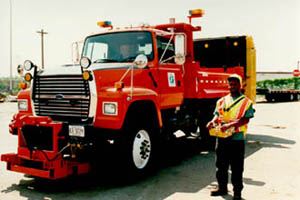U.S. Department of Transportation
Federal Highway Administration
1200 New Jersey Avenue, SE
Washington, DC 20590
202-366-4000
Focus
| Accelerating Infrastructure Innovations |
Publication Number: FHWA-SA-98-023
Date: June 1998
It's been described as the world's biggest Tonka truck, but the remotely driven shadow vehicle (RDV) is no toy-it's a potentially lifesaving tool for highway maintenance crews. Since being assembled under the Strategic Highway Research Program (SHRP) using an idea from the Minnesota Department of Transportation (DOT), the prototype RDV has performed well in work zones and demonstrations.
The prototype does have one significant drawback-it cost $180,000 to build, not including the cost of the truck. The hefty price tag has dampened interest in the RDV. But things may be about to change: Minnesota DOT is testing a new, commercially available kit to convert a truck to remote operation; the kit not only improves the technology used in the prototype, but also sells for just $35,000.
The RDV was conceived as a way to improve on the conventional shadow vehicles often used in highway work zones (see sidebar). These vehicles-typically large dump trucks-follow workers as they move down the highway, serving as moving barriers between work crews and oncoming vehicles. The shadow vehicles lessen the risk for highway workers, but put the driver of the vehicle in a dangerous position should the vehicle be hit.
The RDV removes this danger by taking the driver out of the cab, allowing him or her to operate the vehicle using a remote control unit from the comparative safety of the roadside. The remote control operates the vehicle's steering, accelerator, and brakes, as well as the lights, turn signals, and horn. When not in use as an RDV, the vehicle works like a conventional truck, allowing it to be used for plowing and other jobs.
The new RDV was designed to be as safe as possible, says Chuck Fanslow of Safety Technologies Inc., which developed the vehicle. For example, both the remote control unit in the truck's cab and the handheld control unit have a backup computer. If these computers-or any system in the RDV-stop working properly, the vehicle immediately comes to a halt. A collision-avoidance system ensures that the RDV will automatically stop if there is something in its path. The RDV also stops if its operator fails to remain in nearly constant contact with the remote control. The brakes are even automatically applied whenever the transmission shifts into neutral.
The prototype RDV has proven reliable, but the new version should be even better. Where the prototype used hydraulic motors to manipulate the accelerator, gearshift, and other controls, the new model is almost fully electronic: instead of working the controls, it is programmed to communicate directly with the truck's own computerized engine, transmission, and brake controls.
The extensive use of electronics means that any problems can be easily diagnosed using a portable computer. It also means there are fewer moving parts that can be damaged by exposure to dirt and salt. The system is modular, so when something does go wrong it can be replaced relatively quickly and easily.
The operating system of the new RDV is much more flexible than that in the prototype. A technician can quickly modify the software that runs the RDV's electronics to tailor the RDV to a user's preferences or the requirements of a specific task.
For example, says Minnesota DOT's Ken Nelson, it would take just a few minutes to increase the vehicle's maximum speed to 24 km/h (15 mi/h) from its usual 8 km/h (5 mi/h), which would allow it to keep pace with a stripe-painting truck. In addition, the basic RDV unit can be enhanced to include remote controls for dump truck beds, sand spreaders, and other equipment.
Minnesota DOT took delivery of its first new RDV in early April. Five maintenance crew members were trained in operating the truck, and the RDV is now being thoroughly evaluated by using it to protect workers on Interstate 94 and other high-traffic routes in the Minneapolis area. Minnesota DOT will decide later this year whether to buy more of the new RDVs.
Nelson notes that "the RDV is the only driverless vehicle that's authorized to be on highways," making it an excellent tool for other situations where a driver would be at risk. For example, he says, Minnesota DOT might try modifying an RDV to automatically follow stripe-painting vehicles without requiring an operator to control the truck from the shoulder or the cab.
For more information, contact Ken Nelson at Minnesota DOT (phone: 612-282-5435; fax: 612-296-6758; email: ken.nelson@dot.state.mn.us), Roger Port at FHWA (phone: 816-276-2744; fax: 816-363-3347; email: roger.port@fhwa.dot.gov), or Chuck Fanslow at Safety Technologies, Inc. (phone: 612-388-5030; fax: 612-388-3272; email: cfanslow@autoflagger.com; Web: www.autoflagger.com).

Although similar in appearance to the prototype remotely driven shadow vehicle, this new, commercially available version being evaluated by Minnesota DOT has more advanced technology and a much more affordable price.
Minnesota DOT came up with the idea of a remotely driven shadow vehicle in 1990, when a semitrailer hit one of the highway agency's shadow vehicles and left its driver paralyzed. The tragic accident could ultimately cost the highway agency more than $5 million in workers' compensation.
When SHRP researchers began investigating ways to improve work zone safety, Minnesota DOT suggested the RDV concept and even loaned the program a dump truck for the project. When SHRP ended, the truck-now an RDV-was returned to Minnesota DOT for field testing. The DOT also agreed to demonstrate its use to other States.
The DOT has been working ever since to get an RDV into commercial production. Collaborating with highway agencies in Iowa, New Jersey, and Texas, Minnesota DOT figured out what States wanted in an RDV and at what price. The DOT then encouraged Safety Technologies to develop a product that would serve that market.